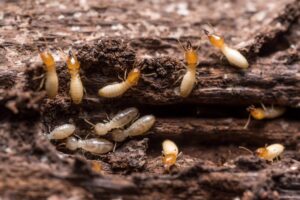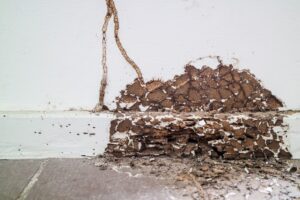All You Need To Know About Termites
TERMITES – A REAL NIGHTMARE FOR HOMEOWNER
Termites are small, winged insects that feed on wood and other cellulose-based materials. They can be found in many parts of Australia, including Brisbane. Termites are a major problem for homeowners, resulting in costly damage to homes and other structures. There are several different types of termites, each with its own characteristics and habits. Identifying the type of termite present is essential for effective treatment.
WHAT ARE TERMITES?
Termites are small, pale-coloured, wood-eating insects that live in large colonies. They can cause significant damage to wooden structures, such as buildings and furniture if left unchecked. Termites are also known as white ants.

TYPES OF TERMITES
There are several different types of termites, including subterranean and drywood termites. Subterranean termites are the most common and live in the ground in large colonies. Drywood termites live in dry wood and can be found in structural timbers, furniture, fences and other wooden structures. Dampwood termites live in damp and decaying wood and can be found in wet, rotting logs and stumps and in Australia are’t considered as economically devastating as other types of termites.
WHAT DAMAGE DO TERMITES MAKE ?
Termites can cause extensive damage to all types of structures such as timber buildings and furniture in as little as 3 months. They feed on wood (cellulose) which can weaken the structural integrity of the timber and cause it to crumble. Termites can also eat through or travel along insulation, wires, metal frames, concrete and other materials that are found in a home or building in order to get to the cellulose they’re looking for. Termites can even cause structural damage to the foundation of a building and this can go undetected until it’s too late.
WHAT ATTRACTS TERMITES?
Termites are attracted to high moisture for example damp soil, bathrooms, kitchens and laundries especially if water leaks are present in these areas. They are attracted to cellulose materials such as wood, paper, and cardboard.
SIGNS OF TERMITES
The most common sign of termite infestation is the presence of mud tubes, which are tunnels built by termites to travel between their nest and their food source. Other signs include the presence of discarded wings, which are the remains of flying termites, and the presence of termite droppings, which resemble sawdust or coffee grounds. If you suspect you may have a termite infestation, it is important to have a professional inspection to identify the type of termite present and assess the level of damage. If you notice any of these, it’s a good idea to call in an expert to inspect your property and determine the extent of the infestation.
Discarded wings
Swarming termites will shed their wings in order to mate and reproduce, leaving piles of wings as evidence of their presence

Mud tubes
Termites create mud tubes to travel between food sources and their nests. These tubes can be found on walls, foundations, and other surfaces.
Damaged wood
Termites consume wood as they tunnel through it, leaving behind hollowed out and weakened structures.
Discoloured paint
Termites can cause paint to discolour and become bubbly, a sign that they are present and actively eating away at the wood.
TERMITE TREATMENTS
If you believe you have a termite infestation, it’s important to call in a pest control expert right away. The expert will be able to determine the extent of the infestation and recommend appropriate treatments. Common treatments for termite infestations include bait systems, soil treatments, and targeted termiticide treatments. Bait systems and some chemical treatments will target the colony of termites, while other chemical treatments will kill termites on contact.
